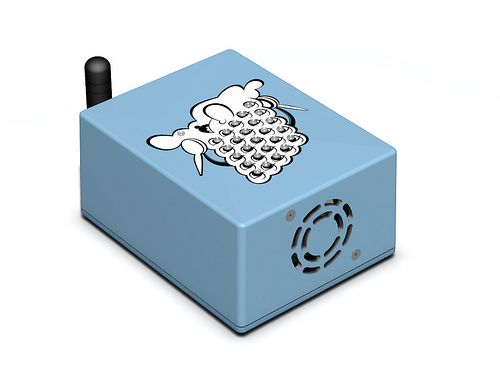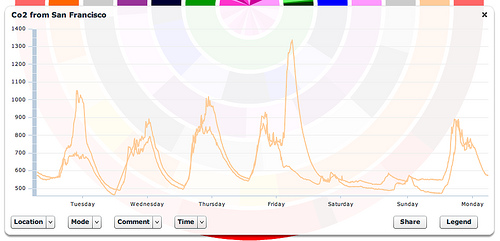
PuffTron photo by miffed
I had previously posted about the Internet of Things and briefly mentioned the Black Cloud project. Internet of Things is a vast topic and I am specifically interested here in remote sensors for sustainability applications. The Black Cloud Citizen Scientist League headed by Art Studio Professor Greg Niemeyer conceived in 2008 a small box called PuffTron which measures CO2, volatile organic compounds, light, noise, head and damp. The solution is based on the ATMega 168 processor and a number of sensors which I couldn’t make out. A server collects the data and delivers interesting visualizations to the web site. One version of the PuffTron transmits data samples via SMS to the server. Below is a short KCET video on the project.
Inducing Change
Last November, Professor Niemeyer posted about the way Black Cloud captured the impact caused by the closure of the Bay Bridge which lasted a few days.
The Bay Bridge closed for a few days, and the CO2 inside an office in SF dropped across the closure period by 25 ppm or about 5%. True, that is not much, but true, there is a direct cause, and it affects us all. So as disastrous and inconvenient the primary effects of closure are, the net benefit in the air is compelling!

Graph by gregoniemeyer
The ability to visualize a situation in terms of its key indicators is crucial for the materialization of a real-time feedback loop. This resonates with the remarks of David Agus speaking at TEDMED 2009 suggesting the importance of indicators as a function of time on a continuous basis in the war on cancer, as opposed to discrete reports produced by annual doctor visits. Global warming, ecosystem service degradation are also symptoms of cancers which need their real-time reporting. A fundamental step in the implementation of a feedback loop to induce change in our society.
What’s interesting about Black Cloud is that its indicators are generic and can be deployed in a multitude of locations. Local specificities will yield different feedback loops and behavior change. This type of hard sensing complements the soft sensing seen in traditional citizen science projects. A generic citizen sensing solution would incorporate this type of service to provide a flexible platform for the sustainability ops room.
 This material is licensed under CC BY 4.0
This material is licensed under CC BY 4.0
